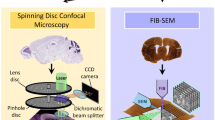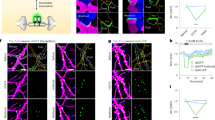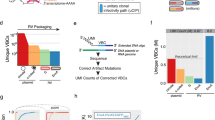Abstract
Many types of questions in neuroscience require the detection and mapping of synapses in the complex mammalian brain. A tool, mammalian GFP reconstitution across synaptic partners (mGRASP), offers a relatively easy, quick and economical approach to this technically challenging task. Here we describe in step-by-step detail the protocols for virus production, gene delivery, brain specimen preparation, fluorescence imaging and image analysis, calibrated substantially and specifically to make mGRASP-assisted circuit mapping (mGRASPing) practical in the mouse brain. The protocol includes troubleshooting suggestions and solutions to common problems. The mGRASP method is suitable for mapping mammalian synaptic connectivity at multiple scales: microscale for synapse-by-synapse or neuron-by-neuron analysis, and mesoscale for revealing local and long-range circuits. The entire protocol takes 5–6 weeks, including time for incubation and virus expression.
This is a preview of subscription content, access via your institution
Access options
Subscribe to this journal
Receive 12 print issues and online access
$259.00 per year
only $21.58 per issue
Buy this article
- Purchase on Springer Link
- Instant access to full article PDF
Prices may be subject to local taxes which are calculated during checkout





Similar content being viewed by others
References
Yook, C., Druckmann, S. & Kim, J. Mapping mammalian synaptic connectivity. Cell Mol. Life Sci. 70, 4747–4757 (2013).
Kleinfeld, D. et al. Large-scale automated histology in the pursuit of connectomes. J. Neurosci. 31, 16125–16138 (2011).
Morgan, J.L. & Lichtman, J.W. Why not connectomics? Nat. Methods 10, 494–500 (2013).
Wickersham, I.R. & Feinberg, E.H. New technologies for imaging synaptic partners. Curr. Opin. Neurobiol. 22, 121–127 (2012).
Bock, D.D. et al. Network anatomy and in vivo physiology of visual cortical neurons. Nature 471, 177–182 (2011).
Briggman, K.L., Helmstaedter, M. & Denk, W. Wiring specificity in the direction-selectivity circuit of the retina. Nature 471, 183–188 (2011).
Livet, J. et al. Transgenic strategies for combinatorial expression of fluorescent proteins in the nervous system. Nature 450, 56–62 (2007).
Cai, D., Cohen, K.B., Luo, T., Lichtman, J.W. & Sanes, J.R. Improved tools for the Brainbow toolbox. Nat. Methods 10, 540–547 (2013).
Micheva, K.D. & Smith, S.J. Array tomography: a new tool for imaging the molecular architecture and ultrastructure of neural circuits. Neuron 55, 25–36 (2007).
Micheva, K.D., Busse, B., Weiler, N.C., O'Rourke, N. & Smith, S.J. Single-synapse analysis of a diverse synapse population: proteomic imaging methods and markers. Neuron 68, 639–653 (2010).
Wickersham, I.R. et al. Monosynaptic restriction of transsynaptic tracing from single, genetically targeted neurons. Neuron 53, 639–647 (2007).
Kim, J. et al. mGRASP enables mapping mammalian synaptic connectivity with light microscopy. Nat. Methods 9, 96–102 (2012).
Feng, L., Zhao, T. & Kim, J. Improved synapse detection for mGRASP-assisted brain connectivity mapping. Bioinformatics 28, I25–I31.
Feinberg, E.H. et al. GFP reconstitution across synaptic partners (GRASP) defines cell contacts and synapses in living nervous systems. Neuron 57, 353–363 (2008).
Druckmann, S. et al. Structured synaptic connectivity between hippocampal regions. Neuron 81, 629–640 (2014).
Zingg, B. et al. Neural networks of the mouse neocortex. Cell 156, 1096–1111 (2014).
Oh, S.W. et al. A mesoscale connectome of the mouse brain. Nature 508, 207–214 (2014).
Grieger, J.C., Choi, V.W. & Samulski, R.J. Production and characterization of adeno-associated viral vectors. Nat. Protoc. 1, 1412–1428 (2006).
Saito, T. In vivo electroporation in the embryonic mouse central nervous system. Nat. Protoc. 1, 1552–1558 (2006).
Navarro-Quiroga, I., Chittajallu, R., Gallo, V. & Haydar, T.F. Long-term, selective gene expression in developing and adult hippocampal pyramidal neurons using focal in utero electroporation. J. Neurosci. 27, 5007–5011 (2007).
Cetin, A., Komai, S., Eliava, M., Seeburg, P.H. & Osten, P. Stereotaxic gene delivery in the rodent brain. Nat. Protoc. 1, 3166–3173 (2006).
Yamagata, M. & Sanes, J.R. Transgenic strategy for identifying synaptic connections in mice by fluorescence complementation (GRASP). Front. Mol. Neurosci. 5, 18 (2012).
Yu, Y.-C., Bultje, R.S., Wang, X. & Shi, S.-H. Specific synapses develop preferentially among sister excitatory neurons in the neocortex. Nature 458, 501–504 (2009).
Wojtowicz, J.M. & Kee, N. BrdU assay for neurogenesis in rodents. Nat. Protoc. 1, 1399–1405 (2006).
Ono, M. et al. Quantitative comparison of anti-fading mounting media for confocal laser scanning microscopy. J. Histochem. Cytochem. 49, 305–312 (2001).
Acknowledgements
We thank M. Son for technical support. This work was supported by the KIST Institutional Program (project no. 2E24210) and by the World Class Institute (WCI) Program of the Nation Research Foundation (NRF) of Korea (NRF grant no. WCI 2009-003).
Author information
Authors and Affiliations
Contributions
O.K., B.L., W.C.O. and J.K. performed the experiments, and L.F. made MATLAB functions for analysis. L.F., O.K. and J.K. drew figures. B.L. and W.C.O. wrote the stereotaxic and specimen preparation sections. L.F. wrote the synapse mapping section. J.K. wrote the paper.
Corresponding author
Ethics declarations
Competing interests
The authors declare no competing financial interests.
Supplementary information
Supplementary Methods
AAV production and titer determination. (PDF 391 kb)
Supplementary Data
The zipped mGRASP detection package named 'puncta'. (ZIP 160 kb)
Rights and permissions
About this article
Cite this article
Feng, L., Kwon, O., Lee, B. et al. Using mammalian GFP reconstitution across synaptic partners (mGRASP) to map synaptic connectivity in the mouse brain. Nat Protoc 9, 2425–2437 (2014). https://doi.org/10.1038/nprot.2014.166
Published:
Issue Date:
DOI: https://doi.org/10.1038/nprot.2014.166
This article is cited by
-
Thalamic circuits for independent control of prefrontal signal and noise
Nature (2021)
-
Separate Gene Transfers into Pre- and Postsynaptic Neocortical Neurons Connected by mGluR5-Containing Synapses
Journal of Molecular Neuroscience (2019)
-
Activity-dependent expression of Channelrhodopsin at neuronal synapses
Nature Communications (2017)
-
An optogenetics- and imaging-assisted simultaneous multiple patch-clamp recording system for decoding complex neural circuits
Nature Protocols (2015)
Comments
By submitting a comment you agree to abide by our Terms and Community Guidelines. If you find something abusive or that does not comply with our terms or guidelines please flag it as inappropriate.



